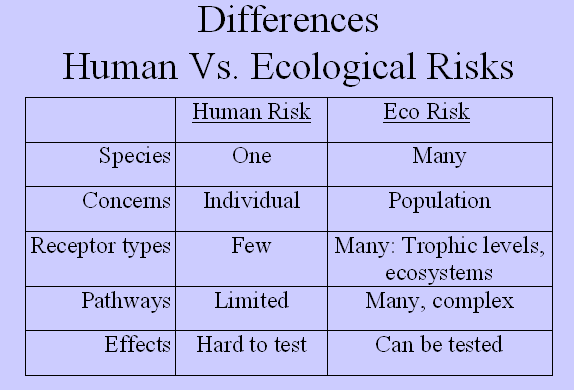Ecological Risk Assessment
"...no adverse effect on human health or the environment." is the
mandate of several environmental laws. From 8B you have a good grasp on the
basics of human health risk assessment. From that base we will talk a little
about adverse effects on the environment. Here are the main differences between
the two types of risk assessment:

Let's discuss each:
- You realize by now that our estimation of low dose effect on humans is at
least one step removed from science for most chemicals, although it is the
best we can do. In any given meso-environment or ecosystem there are hundreds
or thousand of species, from whales to microorganisms. It is rare we know
anything about the toxicity of any particular chemical to more than one or
two of these species. If there is a species that is both convenient and relevant,
it could be tested, just like Cheeech
did to the fish back in Submodule
1E. By convenient I mean amenable to laboratory testing. Relevant means
important to the ecosystem in question, recognized by the public, sensitive
to the chemical. These are often impractical to find, so standard indicator
species are used. These you order from a supply house and they are delivered
in a day or two. Then they are tested with standard EPA protocols. As for
human dose-response estimates, the indicator species are about the best you
can do, given normal limitations of time and budget. The resulting dose-response
numbers may or may not be relevant.
- For human receptors, we do not want to hurt anybody. Now or ever. For animals
in an ecosystem, we can accept some mortality, as long as the population stays
healthy. On a macroscale, the Fish and Game Department manages game populations
this way. For example, while for humans a one in one million or one in ten
thousand chance of harm is acceptable to some. (Note this is computed harm,
it may not hurt anyone.) For damage to an ecosystem, a LD10 might be acceptable.
That is, it will kill 10% of the animal species population. As long as the
PRP ("Potentially Responsible Party, i.e., the polluter) can demonstrate
the population will spring back in a year or two, an LD 50 might be acceptable.
- For humans we sometimes separate male and females. We always separate children.
But that's about it. For ecosystems we must consider trophic levels, i.e.,
the food chain. Ducks eat lead shot from the bottom of the lake, foxes eat
the ducks. Some contaminants increase as they are passed up the food chain
- Effects are impossible to test in humans, but often can be tested in at
least some animals.
- Pathways. We looked at some pathways for human receptors a few pages
back . The next page has the approximate equivalent for an Ecorisk site.
NEXT
Module
8 Index
ENVE 649 Home

